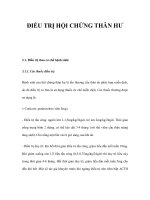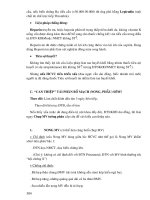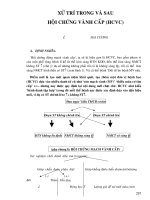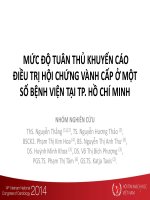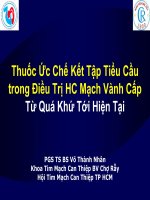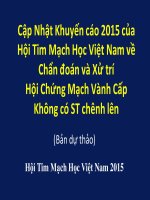TỐI ƯU ĐIỀU TRỊ HỘI CHỨNG VÀNH CẤP - Optimizing treatment for ACS patient with 3 vessel disease & complete heart block Dinh Duc Huy, MD, FSCAI Nguyen Ngo Thanh Phuong, MD Tam Duc Heart Hospital
Bạn đang xem bản rút gọn của tài liệu. Xem và tải ngay bản đầy đủ của tài liệu tại đây (2.43 MB, 30 trang )
HỘI NGHỊ KHOA HỌC TIM MẠCH TOÀN QUỐC 2015
Optimizing treatment
for ACS patient with 3 vessel disease
& complete heart block
Dinh Duc Huy, MD, FSCAI
Nguyen Ngo Thanh Phuong, MD
Tam Duc Heart Hospital
Case presentation
•
•
•
•
•
•
•
•
Mr. D C T, 63 years old
BMI 24 (H 170cm, BW 70kg)
Smoker (+), 50 pack years
Hypercholesterolemia (+)
HTN (+), DM (+) for 10 years
Chest pain sometimes
Weakness and fatigue on exertion 5 days before
Shortness of breath on admission day
Case presentation
•
•
•
•
•
•
•
•
•
Alert
No neurological sign
HR 37 bpm
BP 141/47 mmHg
RR 20 bpm
SpO2 96%
Regular S1, S2
Clear lungs
No lower limbs edema
•
•
•
•
•
•
•
•
•
•
•
WBC 7.71k/uL
HGB 11.7 g/dL
PLT 171K/uL
Creatinin 222 umol/L,
eGFR:27ml/ph/1.73m2
hs-CRP 4.3mg/L
AST 41 U/L
ALT 25 U/L
Cholesterol 2.58
HDL-C 0.72
LDL-C 1.6
TG: 1.74 mmol/L
NT proBNP 9330pg/ml
hs-TnT 126.4->113.8 pg/ml
On admission ECG
Monitoring ECG: BAV II intermittent BAV III
Imaging findings
Chest Xray
• CTR: 0.5
• Normal pulmonary
vascularity
Echocardiography
• LVEF 73%; LV42/24mm
• No RWMA; No thrombus
• Moderate Aortic Stenois
• Gd trans Ao= 42/14 mmHg
• MR (+)
• sPAP 25mmHg
Vascular Ultrasound
• Carotid: no stenosis
•
Normal ABI
•
Lower limbs arteries:
Right: 40-50%%
stenosis of midsuperficial femoral artery
caused by stable plaque
Left: 50% stenosis &
diffuse stenosis after the
bifurcation of the
popliteal artery.
Case management
DIAGNOSIS:
NSTEMI-HTN- T2DM-CKD
Intermittent BAV II-III
TREATMENT:
TPM/PPM?
Coronary angiogram? When?
PCI/CABG before or after PPM?
Anti-platelet therapy? (Pretreatment? Clopidogrel or
New drugs [Pasugrel/Ticagrelor] to be combined
with Aspirin?) for how long?
…
1. The optimal timing of ticagrelor or clopidogrel for patients
scheduled for an invasive strategy has not been adequately
investigated, no recommendation for or against pretreatment
2. Based on the ACCOAST results, pretreatment with prasugrel is
not recommended (TIMI major bleeds were significantly
increased in the pretreatment group at 7 days.
Pretreatment in NSTE-ACS + PCI (RCTs)
Bellemain-Appaix A et al. BMJ 2014;349:g6269
TRANSLATE ACS Registry: 9251 ACS patients
Thienopyridine naive, undergoing PCI- Real life PCI
Effron MB et al. J Am Coll Cardiol. 2014;63(12_S)
Prompt opening of the infarct vessel is often sufficient to
reverse new-onset ischaemic conduction disturbances. This is
especially true for atrioventricular (AV) block in the setting of
inferior infarctions.
Temporary pacing is indicated for symptomatic lifethreatening bradycardia not resolving after successful
reperfusion and after medical treatment in the presence of
high-degree AV block and intraventricular conduction defects.
Permanent pacing is considered for disturbances that persist
beyond the acute phase after the myocardial infarction.
Recommendations for management of new bundle branch block and atrio-ventricular conduction disorders in ACS
Euro Intervention 2014
Case management
•TPM
•TVD- SYNTAX score 22
CABG or PCI
For revascularization?
Tỷ lệ biến cố tim mạch nặng
theo điểm số SYNTAX score
NEJM 2009; 360: 961-72
CABGvs. PCI for
patients with
three-vessel disease:
final 5-year follow up
of the SYNTAX trial
European Heart Journal
doi:10.1093/eurheartj/ehu213
ConclusionFive-year results of
patients with 3VD treated
with CABG or PCI using
the first-generation
paclitaxel-eluting DES
suggest that
CABG should remain the
standard of care
Our patient treatment- 3 VD PCI with DES
•
•
•
•
•
TPM (+)
DES in RCA, LCx, LAD
Good result post PCI
All TIMI 3 flow
Normal sinus rhythm
3 days after PCI
Antiplatelet therapy for ACS patient
1. Which is the best option of antiplatelet
therapy for ACS patient undergoing PCI?
2. Should we do pre-treatment? (perhaps NO)
3. Can we give Ticagrelor for patient with
complete heart block?
4. How long should we prolong DAPT?
CURE study- Corner stone for DAPT in ACS:
Clopidogrel+ ASA are better than ASA alone
PCI Group
Placebo
(11.4%)
0.12
0.20
CVD/MI/Stroke
CV Death, MI, Stroke
0.14
0.10
Clopidogrel
(9.3%)
0.08
0.06
0.04
Clopidogrel
RR 0.80, p<0.001
0
3
RR: 0.72 (0.57-0.90)
6
9
Months of follow-up
0.0
1
2
4
Placebo
0.10
Clopidogrel
100
200
300
Placebo
0.15
Clopidogrel
0.10
0.05
RR: 0.89 (0.71-1.11)
RR: 0.80 (0.69-0.92)
4
CVD/MI/Stroke
0.15
0.0
200
0.20
0.20
0.05
100
CABG Group
Medical Rx Group
CVD/MI/Stroke
0.10
0.05
0.02
0.0
Placebo
0.15
0.0
300
4
100
CURE. NEJM 2001;345:494-502
Fox et al. Circulation. 2004;110:1202-1208,
200
300
Wiviott et al. New Eng J Med 2007; 357
No benefit with prior stroke, age > 75, weight < 60kg
• Multicenter, double-blind,
randomized trial
• 18,624 ACS patients
• Ticagrelor (180-mg loading
dose, 90 mg twice daily
thereafter) and clopidogrel
(300-to-600-mg loadingdose,
75 mg daily thereafter)
Wallentin L et al. N Engl J Med 2009;361
15
Ticargrelor
10
Clopidogrel
11.6%
11.2%
5
P= 0,43
HR: 1.04 (95% CI, 0.95–1.13)
0
0
60
120
180
240
300
Major bleeding in PLATO
360
16
Xuất huyết nặng chung (%)
Xuất huyết nặng chung (%)
Same major bleeding with Ticagrelor vs. Clopidogrel
in PLATO study
Ticagrelor
14
12
13.4%
Clopidogrel 12.6%
10
8
6
P= 0,26
4
HR: 1.07 (95% CI 0.95–1.19
2
0
0
60
120
180
240
300
Major bleeding in
NSTE-ACS subgroup
1. Lindholm D, et al. J Am Coll Cardiol 2013;61(suppl 10):Abstract 901–903.
2. Wallentin L et al. N Engl J Med 2009;361:1045–1057
360
PLATO- Bradycardia Events
Holter monitoring during the first week in 2866 patients
Repeated at 30 days in 1991 patients
Higher incidence of ventricular pauses in the 1st week, but not
at day 30; pauses were rarely associated with symptoms
No significant difference to the incidence of syncope or
pacemaker implantation
Wallentin L et al. N Engl J Med 2009;361
Methods
7-day cECG recording initiated at the time of randomisation, which
was within 24 h of symptom onset, and then repeated at 1 month
after randomization during the convalescent phase.
The principal safety endpoint was the incidence of ventricular
pauses lasting at least 3 seconds.
J Am Coll Cardiol 2011;57:1908–16
cECG Assessment Patient CONSORT Diagram
J Am Coll Cardiol 2011;57:1908–16
Arrhythmias at Visit 1 (Week 1) and
Visit 2 (Day 30) for All Patients
More ventricular pauses ≥3 s in patients assigned to ticagrelor
during the first week (5.8% vs. 3.6%; p=0.006)
At 1 month, pauses ≥3 s were less and similar between treatments
(2.1% vs. 1.7%)
J Am Coll Cardiol 2011;57:1908–16
Other findings
• Week 1: 70 patients
(3.2% ) had 1 pause, 20
(0.6%) had > 4 pauses
• 1 month: 9 patients
(0.05%) had 1 pause, 17
(0.8%) had > 4 pauses
• There is a nocturnal
excess of pauses among
patients assigned to
ticagrelor, with a peak in
the frequency of
ventricular pauses at
night
J Am Coll Cardiol 2011;57:1908–16
Study conclusions
1. More patients treated with ticagrelor compared
with clopidogrel had ventricular pauses, which were
predominantly asymptomatic, sinoatrial nodal in
origin, and nocturnal and occurred most frequently
in the acute phase of ACS.
2. There were no differences between ticagrelor and
clopidogrel in the incidence of clinically reported
bradycardic adverse events, including syncope,
pacemaker placement, and cardiac arrest.
J Am Coll Cardiol 2011;57:1908–16

